Ratio Analysis Report: Financial Performance Analysis of 2018 Data
VerifiedAdded on 2023/06/10
|12
|2287
|407
Report
AI Summary
This report presents a comprehensive ratio analysis of a company's financial performance, comparing 2015 and 2016 data. It delves into profitability ratios like Gross Profit Margin, Return on Total Assets (ROA), and Net Profit to Equity (ROE), alongside efficiency ratios such as Asset Turnover and Collec...

RATIO ANALYSIS
2018
2018
Paraphrase This Document
Need a fresh take? Get an instant paraphrase of this document with our AI Paraphraser
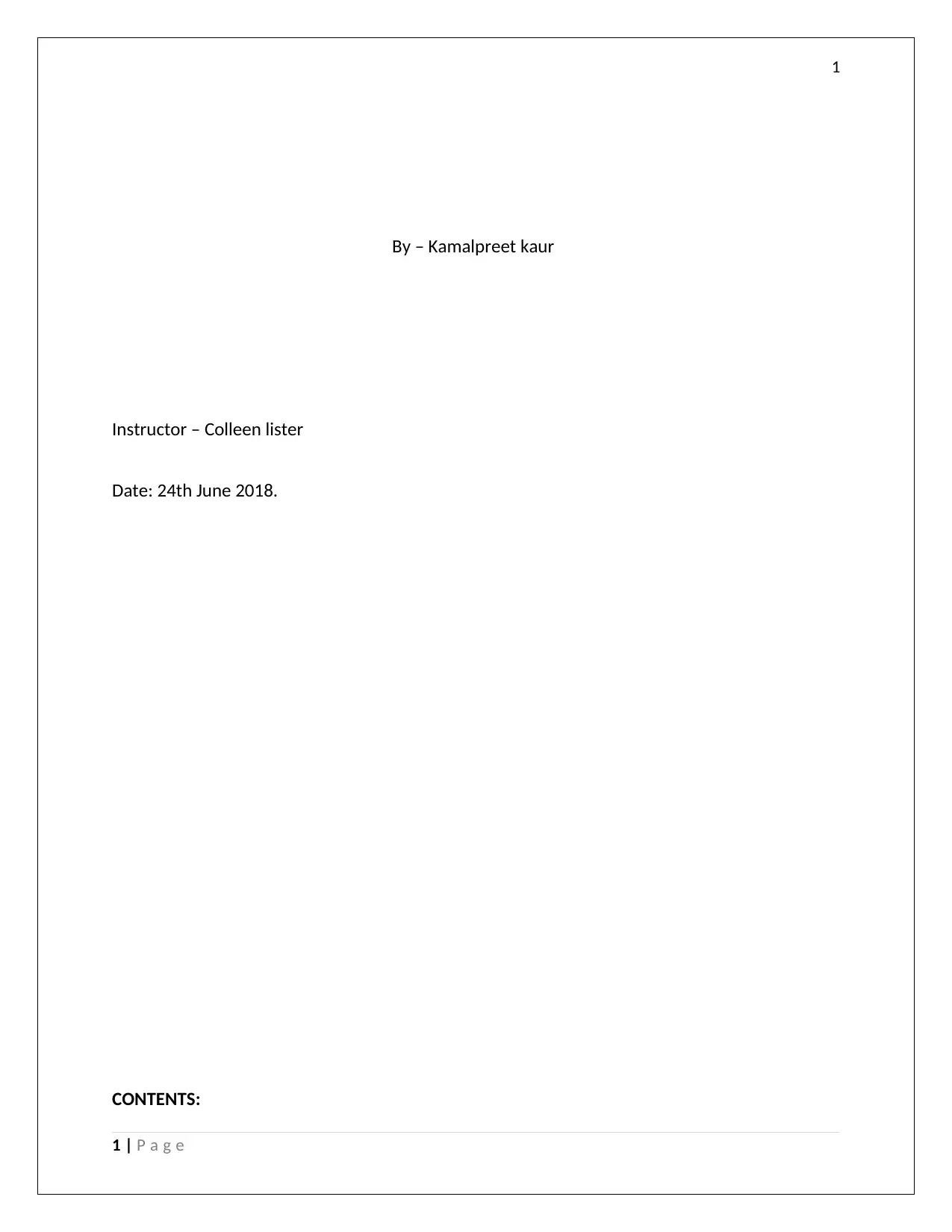
1
By – Kamalpreet kaur
Instructor – Colleen lister
Date: 24th June 2018.
CONTENTS:
1 | P a g e
By – Kamalpreet kaur
Instructor – Colleen lister
Date: 24th June 2018.
CONTENTS:
1 | P a g e

2
Question 1...........…………………………………………………......................…...3
Question 2......................……………….....................................................................4
Question 3......................……………….....................................................................5
Question 4......................……………….....................................................................6
References......................……………….....................................................................7
Question 1
2 | P a g e
Question 1...........…………………………………………………......................…...3
Question 2......................……………….....................................................................4
Question 3......................……………….....................................................................5
Question 4......................……………….....................................................................6
References......................……………….....................................................................7
Question 1
2 | P a g e
⊘ This is a preview!⊘
Do you want full access?
Subscribe today to unlock all pages.

Trusted by 1+ million students worldwide
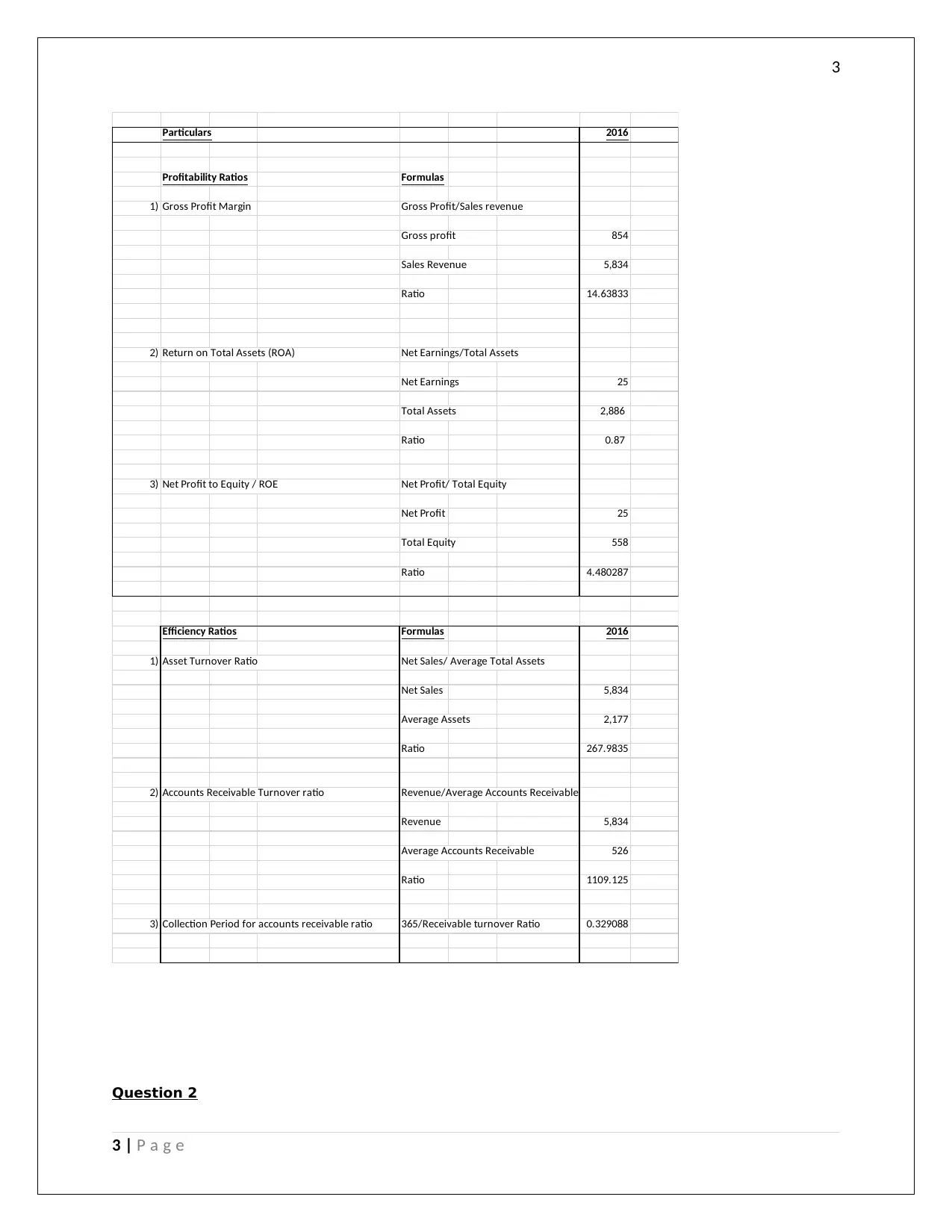
3
Particulars 2016
Profitability Ratios Formulas
1) Gross Profit Margin Gross Profit/Sales revenue
Gross profit 854
Sales Revenue 5,834
Ratio 14.63833
2) Return on Total Assets (ROA) Net Earnings/Total Assets
Net Earnings 25
Total Assets 2,886
Ratio 0.87
3) Net Profit to Equity / ROE Net Profit/ Total Equity
Net Profit 25
Total Equity 558
Ratio 4.480287
Efficiency Ratios Formulas 2016
1) Asset Turnover Ratio Net Sales/ Average Total Assets
Net Sales 5,834
Average Assets 2,177
Ratio 267.9835
2) Accounts Receivable Turnover ratio Revenue/Average Accounts Receivable
Revenue 5,834
Average Accounts Receivable 526
Ratio 1109.125
3) Collection Period for accounts receivable ratio 365/Receivable turnover Ratio 0.329088
Question 2
3 | P a g e
Particulars 2016
Profitability Ratios Formulas
1) Gross Profit Margin Gross Profit/Sales revenue
Gross profit 854
Sales Revenue 5,834
Ratio 14.63833
2) Return on Total Assets (ROA) Net Earnings/Total Assets
Net Earnings 25
Total Assets 2,886
Ratio 0.87
3) Net Profit to Equity / ROE Net Profit/ Total Equity
Net Profit 25
Total Equity 558
Ratio 4.480287
Efficiency Ratios Formulas 2016
1) Asset Turnover Ratio Net Sales/ Average Total Assets
Net Sales 5,834
Average Assets 2,177
Ratio 267.9835
2) Accounts Receivable Turnover ratio Revenue/Average Accounts Receivable
Revenue 5,834
Average Accounts Receivable 526
Ratio 1109.125
3) Collection Period for accounts receivable ratio 365/Receivable turnover Ratio 0.329088
Question 2
3 | P a g e
Paraphrase This Document
Need a fresh take? Get an instant paraphrase of this document with our AI Paraphraser

4
On comparing the ratios calculated in 2015 and 2016 following points can be stated.
Particulars 2016 2015
Profitabilit
y Ratios
Form
ulas
1) Gross Profit
Margin
Gross Profit/Sales
revenue
Gross profit 854 568
Sales
Revenue
5,834 3,432
Ratio 14.63
833
16.55
012
2) Return on Total Assets (ROA) Net Earnings/Total
Assets
Net Earnings 25 124
Total Assets 2
,886
1,469
Ratio
0.87
8.441
116
3) Net Profit to Equity / ROE Net Profit/ Total Equity
4 | P a g e
On comparing the ratios calculated in 2015 and 2016 following points can be stated.
Particulars 2016 2015
Profitabilit
y Ratios
Form
ulas
1) Gross Profit
Margin
Gross Profit/Sales
revenue
Gross profit 854 568
Sales
Revenue
5,834 3,432
Ratio 14.63
833
16.55
012
2) Return on Total Assets (ROA) Net Earnings/Total
Assets
Net Earnings 25 124
Total Assets 2
,886
1,469
Ratio
0.87
8.441
116
3) Net Profit to Equity / ROE Net Profit/ Total Equity
4 | P a g e

5
Net
Profit
25 124
Total Equity 558 664
Ratio 4.480
287
18.67
47
1. Gross Profit Margin – This ratio helps in showing how much profit the company is making in
comparison to the total sales of the company.The higher the gross profit ratio, the better it is.
It reflects the overall policies of the company which comes from cost of goods sold and other
credit giving facilities that the company have (Alsagoff, 2010). In the given case of the
company in comparing both the given years 2016 and 2015 we see that in 2016 the ratio was
14.63% and in 2015 the ratio was 16.55%, so this an adverse condition and the company
needs to see why there is a detoriation in the ratios from the prior years and how it can be
improved.
2. Return on Total Assets – The ROA shows the overall return on the assets of the company by
comparing the net profit of the company with the total assets. The higher the ratio the better it
is as it shows that the company is earning enough profit in comparison to the total money that
it has invested in its assets. Thus it can be said that the company is making good use of all its
assets for generating effective revenue for the company. In comparing the given years 2016
and 2015, it can be seen that in 2015 the ratio was 8.44% and in 2016 the ratio is 0.87 %, so
that is a darastic fall and it shows that the company is not functioning to the best of its abilities
as the net profit is less in comparison to the amount of assets the company is having. From
2015 to 2016, there has been a lot of fall in the ROA and thus this shows that the financial
health of the company is not in the best condition and in case the company wants to do better
they need to analyse the reasons for such discripancies and make effective use of the assets
(Kusolpalalert, 2018).
3. ROE/ Net Profit to the Equity – This ratio shows the overall return on the equity of the company
by comparing it with the net profit of the company. This is one of the most important
profitability ratios for the investors as it helps them to understand whether the company is
paying good returns on the equity investment to the shareholders of the company. A high ROE
is better as it reflects a better financial position and which means that the company is making
better returns and thus this puts the shareholders in a good position. On comparing the ROE of
2015 and 2016, we see that in 2016 the ration was 4.4 % and in 2015 the ratio was 18.67 %,
thus we see that there was a detoriation from the prior year, and thus there should be an
5 | P a g e
Net
Profit
25 124
Total Equity 558 664
Ratio 4.480
287
18.67
47
1. Gross Profit Margin – This ratio helps in showing how much profit the company is making in
comparison to the total sales of the company.The higher the gross profit ratio, the better it is.
It reflects the overall policies of the company which comes from cost of goods sold and other
credit giving facilities that the company have (Alsagoff, 2010). In the given case of the
company in comparing both the given years 2016 and 2015 we see that in 2016 the ratio was
14.63% and in 2015 the ratio was 16.55%, so this an adverse condition and the company
needs to see why there is a detoriation in the ratios from the prior years and how it can be
improved.
2. Return on Total Assets – The ROA shows the overall return on the assets of the company by
comparing the net profit of the company with the total assets. The higher the ratio the better it
is as it shows that the company is earning enough profit in comparison to the total money that
it has invested in its assets. Thus it can be said that the company is making good use of all its
assets for generating effective revenue for the company. In comparing the given years 2016
and 2015, it can be seen that in 2015 the ratio was 8.44% and in 2016 the ratio is 0.87 %, so
that is a darastic fall and it shows that the company is not functioning to the best of its abilities
as the net profit is less in comparison to the amount of assets the company is having. From
2015 to 2016, there has been a lot of fall in the ROA and thus this shows that the financial
health of the company is not in the best condition and in case the company wants to do better
they need to analyse the reasons for such discripancies and make effective use of the assets
(Kusolpalalert, 2018).
3. ROE/ Net Profit to the Equity – This ratio shows the overall return on the equity of the company
by comparing it with the net profit of the company. This is one of the most important
profitability ratios for the investors as it helps them to understand whether the company is
paying good returns on the equity investment to the shareholders of the company. A high ROE
is better as it reflects a better financial position and which means that the company is making
better returns and thus this puts the shareholders in a good position. On comparing the ROE of
2015 and 2016, we see that in 2016 the ration was 4.4 % and in 2015 the ratio was 18.67 %,
thus we see that there was a detoriation from the prior year, and thus there should be an
5 | P a g e
⊘ This is a preview!⊘
Do you want full access?
Subscribe today to unlock all pages.

Trusted by 1+ million students worldwide
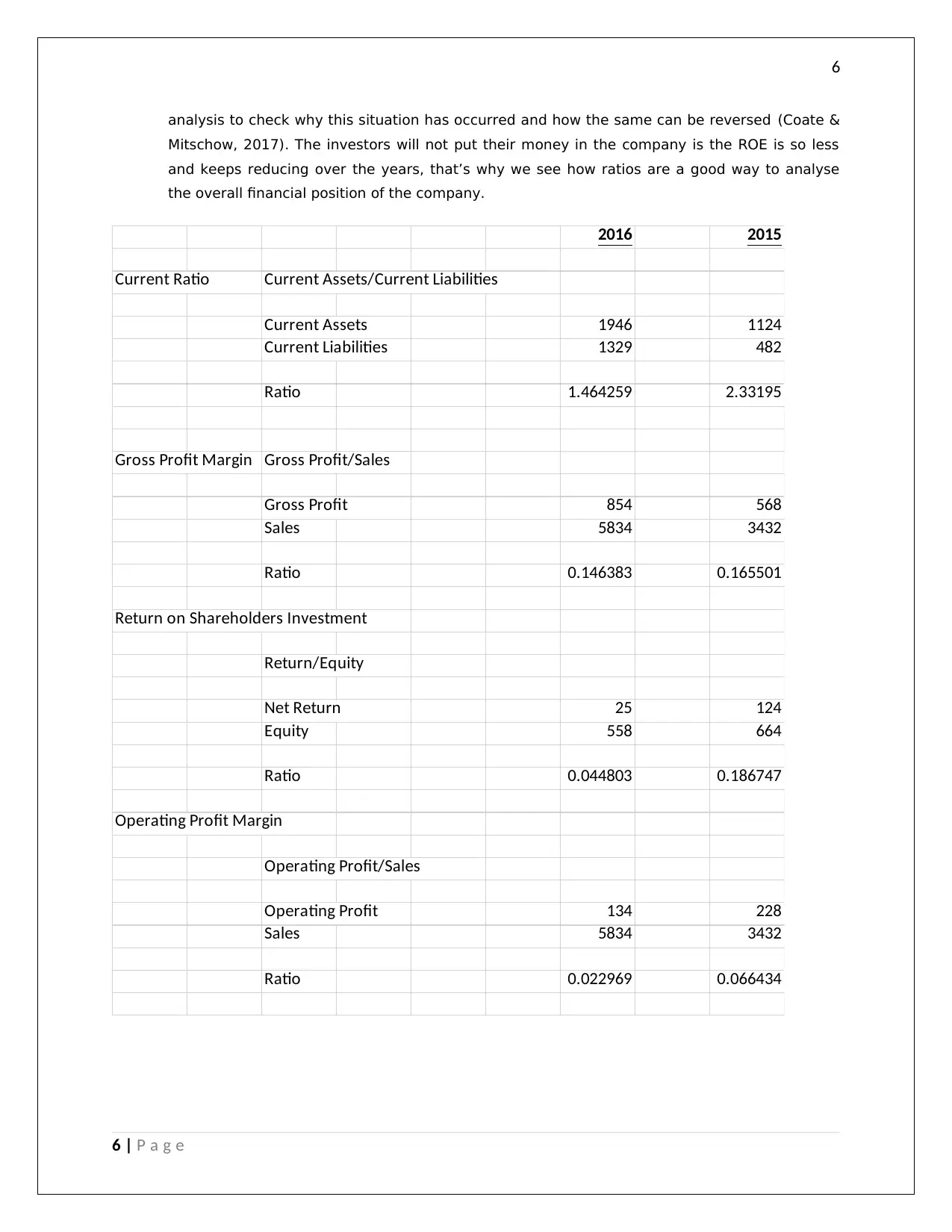
6
analysis to check why this situation has occurred and how the same can be reversed (Coate &
Mitschow, 2017). The investors will not put their money in the company is the ROE is so less
and keeps reducing over the years, that’s why we see how ratios are a good way to analyse
the overall financial position of the company.
2016 2015
Current Ratio Current Assets/Current Liabilities
Current Assets 1946 1124
Current Liabilities 1329 482
Ratio 1.464259 2.33195
Gross Profit Margin Gross Profit/Sales
Gross Profit 854 568
Sales 5834 3432
Ratio 0.146383 0.165501
Return on Shareholders Investment
Return/Equity
Net Return 25 124
Equity 558 664
Ratio 0.044803 0.186747
Operating Profit Margin
Operating Profit/Sales
Operating Profit 134 228
Sales 5834 3432
Ratio 0.022969 0.066434
6 | P a g e
analysis to check why this situation has occurred and how the same can be reversed (Coate &
Mitschow, 2017). The investors will not put their money in the company is the ROE is so less
and keeps reducing over the years, that’s why we see how ratios are a good way to analyse
the overall financial position of the company.
2016 2015
Current Ratio Current Assets/Current Liabilities
Current Assets 1946 1124
Current Liabilities 1329 482
Ratio 1.464259 2.33195
Gross Profit Margin Gross Profit/Sales
Gross Profit 854 568
Sales 5834 3432
Ratio 0.146383 0.165501
Return on Shareholders Investment
Return/Equity
Net Return 25 124
Equity 558 664
Ratio 0.044803 0.186747
Operating Profit Margin
Operating Profit/Sales
Operating Profit 134 228
Sales 5834 3432
Ratio 0.022969 0.066434
6 | P a g e
Paraphrase This Document
Need a fresh take? Get an instant paraphrase of this document with our AI Paraphraser
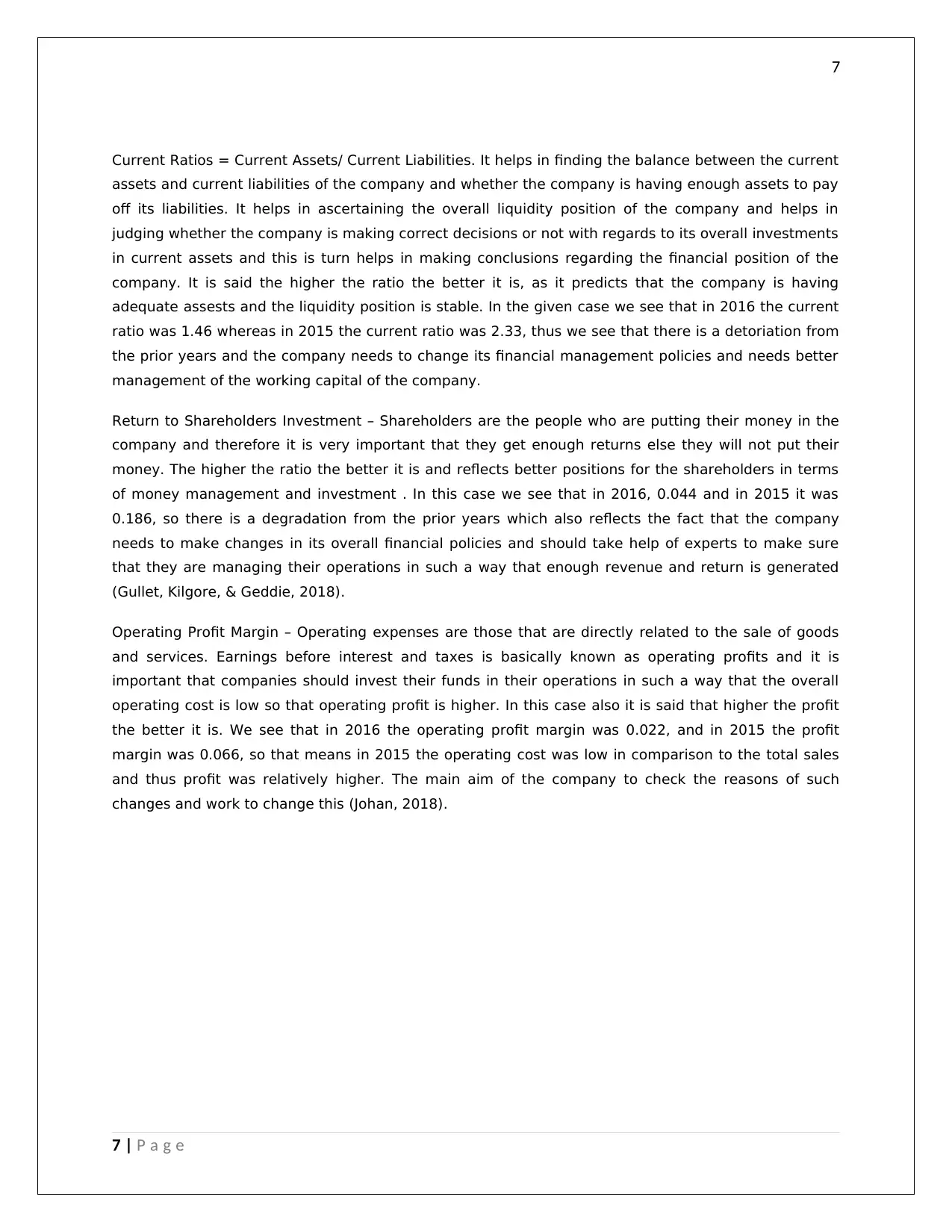
7
Current Ratios = Current Assets/ Current Liabilities. It helps in finding the balance between the current
assets and current liabilities of the company and whether the company is having enough assets to pay
off its liabilities. It helps in ascertaining the overall liquidity position of the company and helps in
judging whether the company is making correct decisions or not with regards to its overall investments
in current assets and this is turn helps in making conclusions regarding the financial position of the
company. It is said the higher the ratio the better it is, as it predicts that the company is having
adequate assests and the liquidity position is stable. In the given case we see that in 2016 the current
ratio was 1.46 whereas in 2015 the current ratio was 2.33, thus we see that there is a detoriation from
the prior years and the company needs to change its financial management policies and needs better
management of the working capital of the company.
Return to Shareholders Investment – Shareholders are the people who are putting their money in the
company and therefore it is very important that they get enough returns else they will not put their
money. The higher the ratio the better it is and reflects better positions for the shareholders in terms
of money management and investment . In this case we see that in 2016, 0.044 and in 2015 it was
0.186, so there is a degradation from the prior years which also reflects the fact that the company
needs to make changes in its overall financial policies and should take help of experts to make sure
that they are managing their operations in such a way that enough revenue and return is generated
(Gullet, Kilgore, & Geddie, 2018).
Operating Profit Margin – Operating expenses are those that are directly related to the sale of goods
and services. Earnings before interest and taxes is basically known as operating profits and it is
important that companies should invest their funds in their operations in such a way that the overall
operating cost is low so that operating profit is higher. In this case also it is said that higher the profit
the better it is. We see that in 2016 the operating profit margin was 0.022, and in 2015 the profit
margin was 0.066, so that means in 2015 the operating cost was low in comparison to the total sales
and thus profit was relatively higher. The main aim of the company to check the reasons of such
changes and work to change this (Johan, 2018).
7 | P a g e
Current Ratios = Current Assets/ Current Liabilities. It helps in finding the balance between the current
assets and current liabilities of the company and whether the company is having enough assets to pay
off its liabilities. It helps in ascertaining the overall liquidity position of the company and helps in
judging whether the company is making correct decisions or not with regards to its overall investments
in current assets and this is turn helps in making conclusions regarding the financial position of the
company. It is said the higher the ratio the better it is, as it predicts that the company is having
adequate assests and the liquidity position is stable. In the given case we see that in 2016 the current
ratio was 1.46 whereas in 2015 the current ratio was 2.33, thus we see that there is a detoriation from
the prior years and the company needs to change its financial management policies and needs better
management of the working capital of the company.
Return to Shareholders Investment – Shareholders are the people who are putting their money in the
company and therefore it is very important that they get enough returns else they will not put their
money. The higher the ratio the better it is and reflects better positions for the shareholders in terms
of money management and investment . In this case we see that in 2016, 0.044 and in 2015 it was
0.186, so there is a degradation from the prior years which also reflects the fact that the company
needs to make changes in its overall financial policies and should take help of experts to make sure
that they are managing their operations in such a way that enough revenue and return is generated
(Gullet, Kilgore, & Geddie, 2018).
Operating Profit Margin – Operating expenses are those that are directly related to the sale of goods
and services. Earnings before interest and taxes is basically known as operating profits and it is
important that companies should invest their funds in their operations in such a way that the overall
operating cost is low so that operating profit is higher. In this case also it is said that higher the profit
the better it is. We see that in 2016 the operating profit margin was 0.022, and in 2015 the profit
margin was 0.066, so that means in 2015 the operating cost was low in comparison to the total sales
and thus profit was relatively higher. The main aim of the company to check the reasons of such
changes and work to change this (Johan, 2018).
7 | P a g e
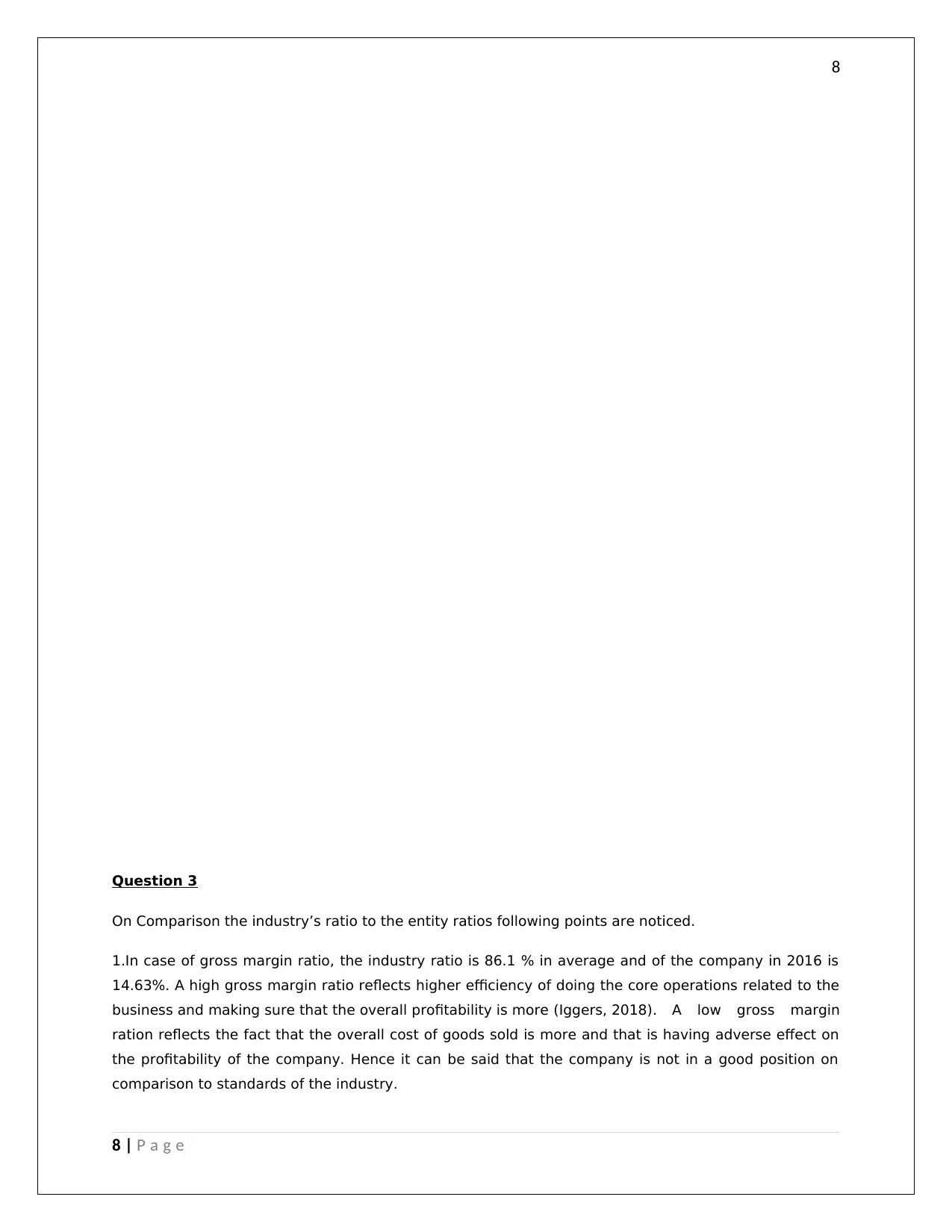
8
Question 3
On Comparison the industry’s ratio to the entity ratios following points are noticed.
1.In case of gross margin ratio, the industry ratio is 86.1 % in average and of the company in 2016 is
14.63%. A high gross margin ratio reflects higher efficiency of doing the core operations related to the
business and making sure that the overall profitability is more (Iggers, 2018). A low gross margin
ration reflects the fact that the overall cost of goods sold is more and that is having adverse effect on
the profitability of the company. Hence it can be said that the company is not in a good position on
comparison to standards of the industry.
8 | P a g e
Question 3
On Comparison the industry’s ratio to the entity ratios following points are noticed.
1.In case of gross margin ratio, the industry ratio is 86.1 % in average and of the company in 2016 is
14.63%. A high gross margin ratio reflects higher efficiency of doing the core operations related to the
business and making sure that the overall profitability is more (Iggers, 2018). A low gross margin
ration reflects the fact that the overall cost of goods sold is more and that is having adverse effect on
the profitability of the company. Hence it can be said that the company is not in a good position on
comparison to standards of the industry.
8 | P a g e
⊘ This is a preview!⊘
Do you want full access?
Subscribe today to unlock all pages.

Trusted by 1+ million students worldwide
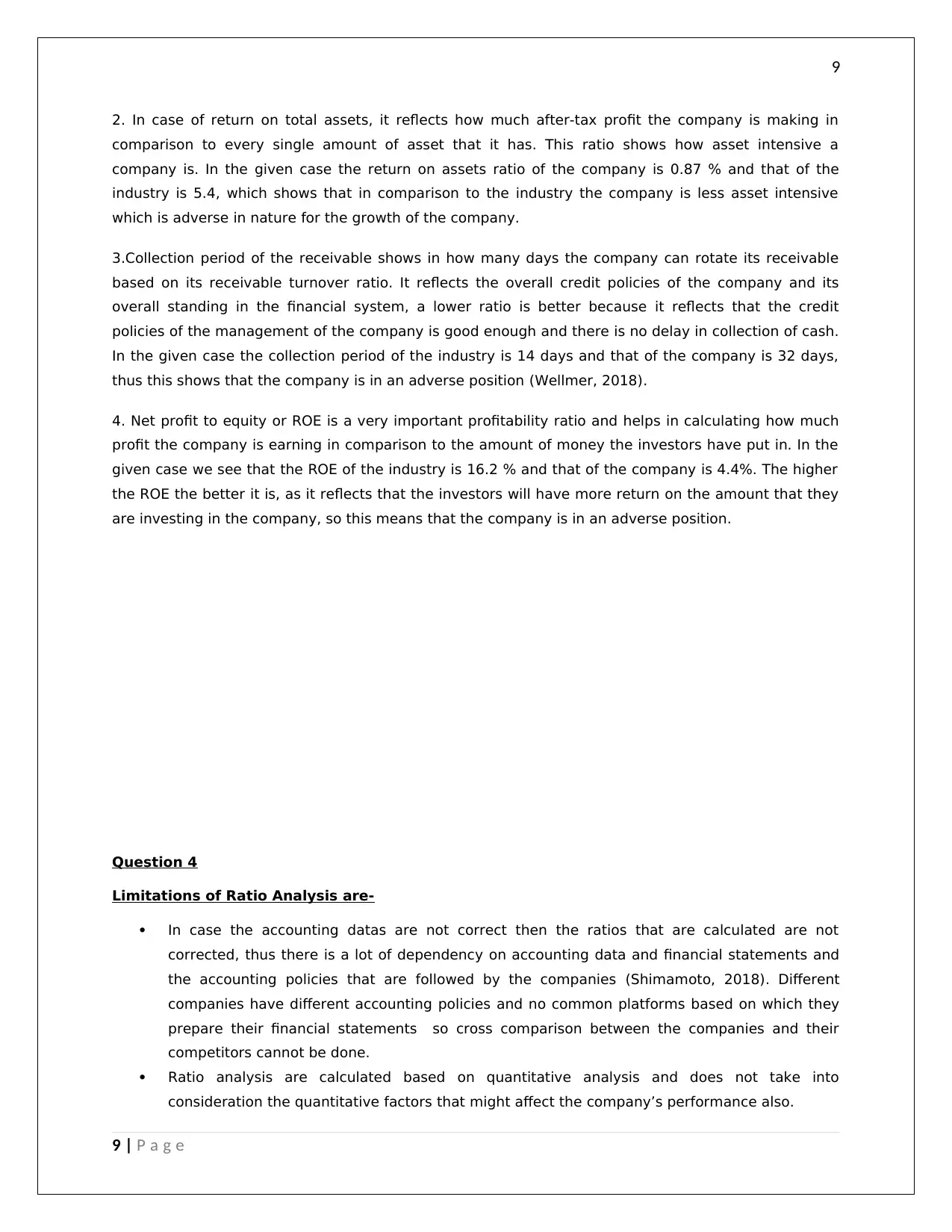
9
2. In case of return on total assets, it reflects how much after-tax profit the company is making in
comparison to every single amount of asset that it has. This ratio shows how asset intensive a
company is. In the given case the return on assets ratio of the company is 0.87 % and that of the
industry is 5.4, which shows that in comparison to the industry the company is less asset intensive
which is adverse in nature for the growth of the company.
3.Collection period of the receivable shows in how many days the company can rotate its receivable
based on its receivable turnover ratio. It reflects the overall credit policies of the company and its
overall standing in the financial system, a lower ratio is better because it reflects that the credit
policies of the management of the company is good enough and there is no delay in collection of cash.
In the given case the collection period of the industry is 14 days and that of the company is 32 days,
thus this shows that the company is in an adverse position (Wellmer, 2018).
4. Net profit to equity or ROE is a very important profitability ratio and helps in calculating how much
profit the company is earning in comparison to the amount of money the investors have put in. In the
given case we see that the ROE of the industry is 16.2 % and that of the company is 4.4%. The higher
the ROE the better it is, as it reflects that the investors will have more return on the amount that they
are investing in the company, so this means that the company is in an adverse position.
Question 4
Limitations of Ratio Analysis are-
In case the accounting datas are not correct then the ratios that are calculated are not
corrected, thus there is a lot of dependency on accounting data and financial statements and
the accounting policies that are followed by the companies (Shimamoto, 2018). Different
companies have different accounting policies and no common platforms based on which they
prepare their financial statements so cross comparison between the companies and their
competitors cannot be done.
Ratio analysis are calculated based on quantitative analysis and does not take into
consideration the quantitative factors that might affect the company’s performance also.
9 | P a g e
2. In case of return on total assets, it reflects how much after-tax profit the company is making in
comparison to every single amount of asset that it has. This ratio shows how asset intensive a
company is. In the given case the return on assets ratio of the company is 0.87 % and that of the
industry is 5.4, which shows that in comparison to the industry the company is less asset intensive
which is adverse in nature for the growth of the company.
3.Collection period of the receivable shows in how many days the company can rotate its receivable
based on its receivable turnover ratio. It reflects the overall credit policies of the company and its
overall standing in the financial system, a lower ratio is better because it reflects that the credit
policies of the management of the company is good enough and there is no delay in collection of cash.
In the given case the collection period of the industry is 14 days and that of the company is 32 days,
thus this shows that the company is in an adverse position (Wellmer, 2018).
4. Net profit to equity or ROE is a very important profitability ratio and helps in calculating how much
profit the company is earning in comparison to the amount of money the investors have put in. In the
given case we see that the ROE of the industry is 16.2 % and that of the company is 4.4%. The higher
the ROE the better it is, as it reflects that the investors will have more return on the amount that they
are investing in the company, so this means that the company is in an adverse position.
Question 4
Limitations of Ratio Analysis are-
In case the accounting datas are not correct then the ratios that are calculated are not
corrected, thus there is a lot of dependency on accounting data and financial statements and
the accounting policies that are followed by the companies (Shimamoto, 2018). Different
companies have different accounting policies and no common platforms based on which they
prepare their financial statements so cross comparison between the companies and their
competitors cannot be done.
Ratio analysis are calculated based on quantitative analysis and does not take into
consideration the quantitative factors that might affect the company’s performance also.
9 | P a g e
Paraphrase This Document
Need a fresh take? Get an instant paraphrase of this document with our AI Paraphraser
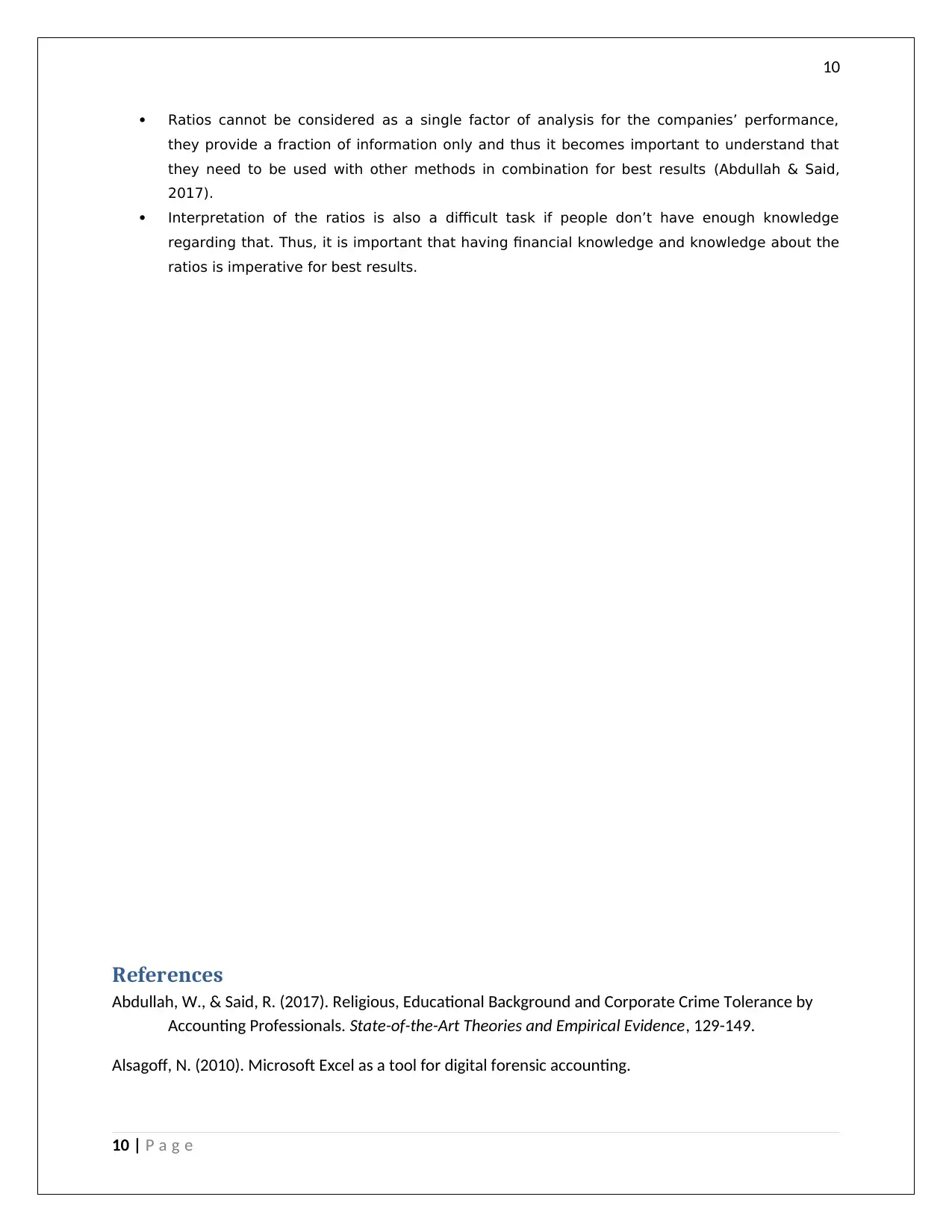
10
Ratios cannot be considered as a single factor of analysis for the companies’ performance,
they provide a fraction of information only and thus it becomes important to understand that
they need to be used with other methods in combination for best results (Abdullah & Said,
2017).
Interpretation of the ratios is also a difficult task if people don’t have enough knowledge
regarding that. Thus, it is important that having financial knowledge and knowledge about the
ratios is imperative for best results.
References
Abdullah, W., & Said, R. (2017). Religious, Educational Background and Corporate Crime Tolerance by
Accounting Professionals. State-of-the-Art Theories and Empirical Evidence, 129-149.
Alsagoff, N. (2010). Microsoft Excel as a tool for digital forensic accounting.
10 | P a g e
Ratios cannot be considered as a single factor of analysis for the companies’ performance,
they provide a fraction of information only and thus it becomes important to understand that
they need to be used with other methods in combination for best results (Abdullah & Said,
2017).
Interpretation of the ratios is also a difficult task if people don’t have enough knowledge
regarding that. Thus, it is important that having financial knowledge and knowledge about the
ratios is imperative for best results.
References
Abdullah, W., & Said, R. (2017). Religious, Educational Background and Corporate Crime Tolerance by
Accounting Professionals. State-of-the-Art Theories and Empirical Evidence, 129-149.
Alsagoff, N. (2010). Microsoft Excel as a tool for digital forensic accounting.
10 | P a g e
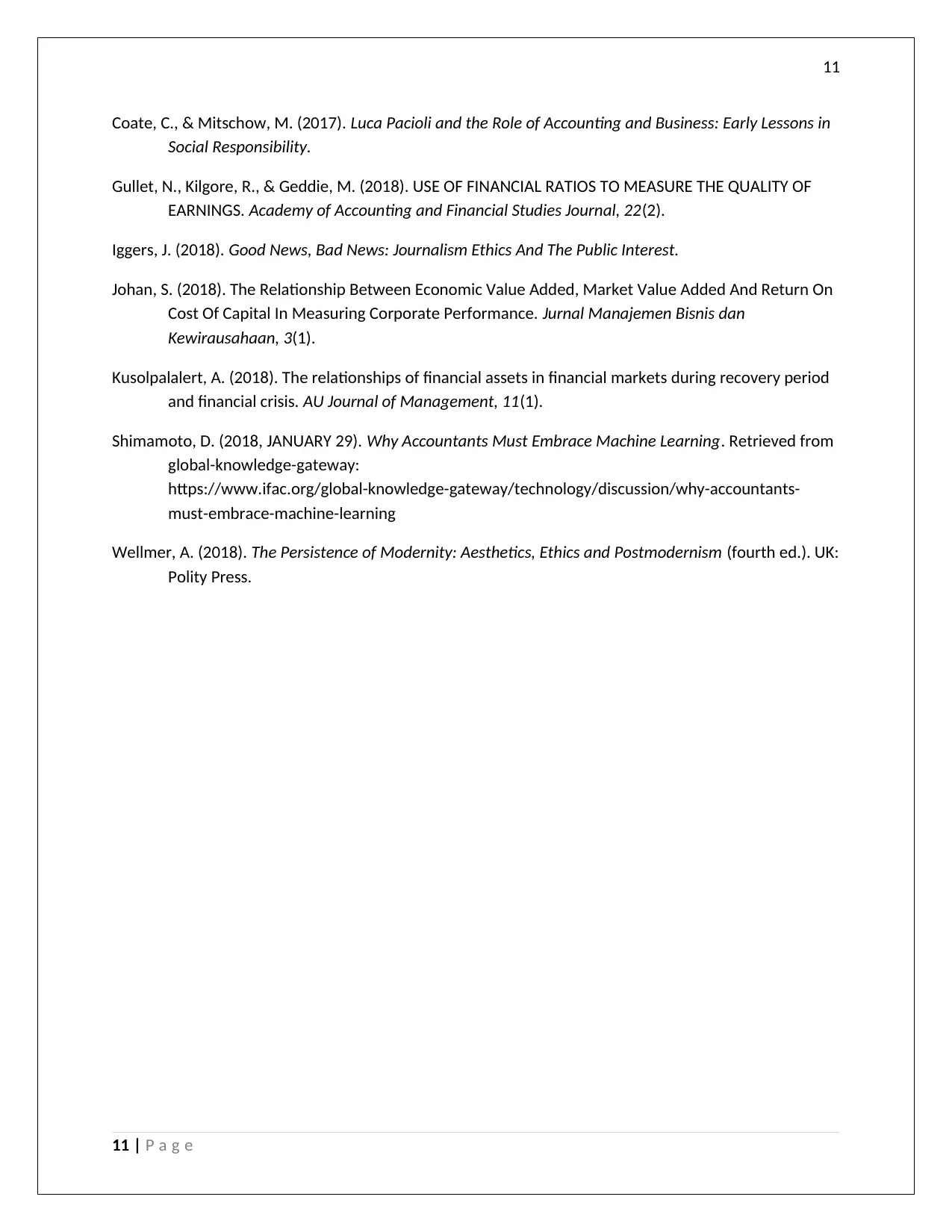
11
Coate, C., & Mitschow, M. (2017). Luca Pacioli and the Role of Accounting and Business: Early Lessons in
Social Responsibility.
Gullet, N., Kilgore, R., & Geddie, M. (2018). USE OF FINANCIAL RATIOS TO MEASURE THE QUALITY OF
EARNINGS. Academy of Accounting and Financial Studies Journal, 22(2).
Iggers, J. (2018). Good News, Bad News: Journalism Ethics And The Public Interest.
Johan, S. (2018). The Relationship Between Economic Value Added, Market Value Added And Return On
Cost Of Capital In Measuring Corporate Performance. Jurnal Manajemen Bisnis dan
Kewirausahaan, 3(1).
Kusolpalalert, A. (2018). The relationships of financial assets in financial markets during recovery period
and financial crisis. AU Journal of Management, 11(1).
Shimamoto, D. (2018, JANUARY 29). Why Accountants Must Embrace Machine Learning. Retrieved from
global-knowledge-gateway:
https://www.ifac.org/global-knowledge-gateway/technology/discussion/why-accountants-
must-embrace-machine-learning
Wellmer, A. (2018). The Persistence of Modernity: Aesthetics, Ethics and Postmodernism (fourth ed.). UK:
Polity Press.
11 | P a g e
Coate, C., & Mitschow, M. (2017). Luca Pacioli and the Role of Accounting and Business: Early Lessons in
Social Responsibility.
Gullet, N., Kilgore, R., & Geddie, M. (2018). USE OF FINANCIAL RATIOS TO MEASURE THE QUALITY OF
EARNINGS. Academy of Accounting and Financial Studies Journal, 22(2).
Iggers, J. (2018). Good News, Bad News: Journalism Ethics And The Public Interest.
Johan, S. (2018). The Relationship Between Economic Value Added, Market Value Added And Return On
Cost Of Capital In Measuring Corporate Performance. Jurnal Manajemen Bisnis dan
Kewirausahaan, 3(1).
Kusolpalalert, A. (2018). The relationships of financial assets in financial markets during recovery period
and financial crisis. AU Journal of Management, 11(1).
Shimamoto, D. (2018, JANUARY 29). Why Accountants Must Embrace Machine Learning. Retrieved from
global-knowledge-gateway:
https://www.ifac.org/global-knowledge-gateway/technology/discussion/why-accountants-
must-embrace-machine-learning
Wellmer, A. (2018). The Persistence of Modernity: Aesthetics, Ethics and Postmodernism (fourth ed.). UK:
Polity Press.
11 | P a g e
⊘ This is a preview!⊘
Do you want full access?
Subscribe today to unlock all pages.

Trusted by 1+ million students worldwide
1 out of 12
Related Documents
Your All-in-One AI-Powered Toolkit for Academic Success.
+13062052269
info@desklib.com
Available 24*7 on WhatsApp / Email
![[object Object]](/_next/static/media/star-bottom.7253800d.svg)
Unlock your academic potential
© 2024 | Zucol Services PVT LTD | All rights reserved.





